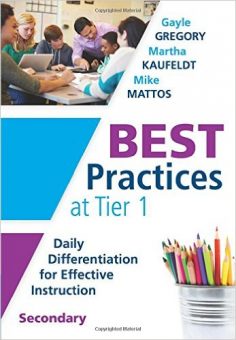Effective Differentiation in Grades 7 and Up
Best Practices at Tier 1: Daily Differentiation for Effective Instruction, Secondary
By Gayle Gregory, Martha Kaufeldt, and Mike Mattos
(Solution Tree, 2015 – Learn more)
Reviewed by Mark A. Domeier
Gregory, Kaufeldt, and Mattos produce a mixed bag with their look at best practices at the secondary level with regards to differentiation. There are some great ideas spread throughout the book and then suggestions that are a little more difficult to accept.
That said, by the end of the book, every teacher is likely to have found some new ideas to try in the classroom, and that always makes a book a worthwhile read.
Much Needed Differentiation for 7-12

It’s impossible to avoid ideas like differentiation and RtI, but the path to these in the classroom, especially at a secondary level, have always been murky or worse. That’s the best part of this book: it absolutely puts everything at the level of a teacher for grades 7-12.
Too many educational books write about concepts in a broad sense, and it always seems easier to couch them in a way that works well K-6. The secondary building is an entirely different beast, and how to transition students and ideas to that level has been a constant struggle.
Reading about growth mindset and giving chances to students to redo work and show improvement hit the nail on the head. Too many students just shrug their shoulders and move on to the next task, even if they didn’t understand the previous one. By constantly stressing improvement, teachers can better guide kids along a path toward proficiency.
As someone who has tinkered with these classroom values the last few years, I can say that it’s a good move to make, but also that it takes some time to change students’ mindsets.
Ideas to Reshape My Classroom
The sections regarding student collaboration and group work are outstanding. I had a hard time falling asleep after reading that part because my mind was racing with ideas to reshape my classroom next fall. This part alone made the entire book worth reading, based on the impact I foresee it having on my students for years to come.
The examples provided for ways to implement differentiation are good, but there aren’t nearly enough. The biggest complaint as education heads in this direction, again from veteran teachers, is guidance in how to take units we teach and apply these ideas. You can teach an old dog new tricks, but it takes more than a half-day in-service with one presenter and 50 teachers.
That’s a little of how the examples feel in the book: not enough to do more than get me started. I’d pay for a book that dissected the standards and focused strictly on ideas for how to differentiate them.
Questions on Leveling
The book takes swipes at leveling students, but isn’t that essentially RtI on a larger scale? Again, it’s so tough to change the schedule at a secondary building, but by placing students who have higher skills in reading in one section, the teacher is able to teach some different material and push those students. By the same logic, a group of lower skills students will benefit by learning much of the same material as their peers, but having it taught a different way, differentiating it from that of their peers. The problem here is the book doesn’t say why leveling is bad, just that it is.
Challenging Time Demands
Like many education books, there is a bit of pie-in-the-sky here. To do most of what is suggested here, a teacher would have to spend at least 12 hours a day at school. Most of us put in plenty of time outside of our scheduled day, but to follow all these ideas would be a quick way to burn out. While the authors suggest a lot of collaboration, they fail to bring the idea to those of us who teach in smaller districts. Exactly who do I collaborate with when I teach all the 7th and 8th graders? PLCs don’t work as well when everyone in the English department teaches different classes!
See Curriculum Differently
At the end of the day, this was a book worth reading. As mentioned, readers should be able to find something that will work and will look at curriculum differently. You may find you can skim over areas you’ve become familiar with through other school initiatives, but you will encounter some thoughts that are worth reading again as you prepare for the next school year.
Mark A. Domeier has taught English in the New Richland-Hartland-Ellendale-Geneva school district in Minnesota for 20 years, spending most of that time in the junior high. Mark has published two books, Heroics 101 and Heroics 201, and writes a weekly column for the local paper. Mark and his wife Michelle live in Ellendale with their two children and their cat, Chewbacca.


































I have been incorporating DI into my middle school math class as a regular part of each day for a few years. I do the DI for the last 10 minutes of each period. It has had a huge impact on student outcomes. It has definitely been worth the upfront work. I have a blog post on one of the activities I have used for decimal division. It includes free downloadable resources for the game. Caveat, you have to buy your own Jenga game to use with it. https://matheasyaspi.wordpress.com/2016/05/10/timber-di-decimal-division-jenga/